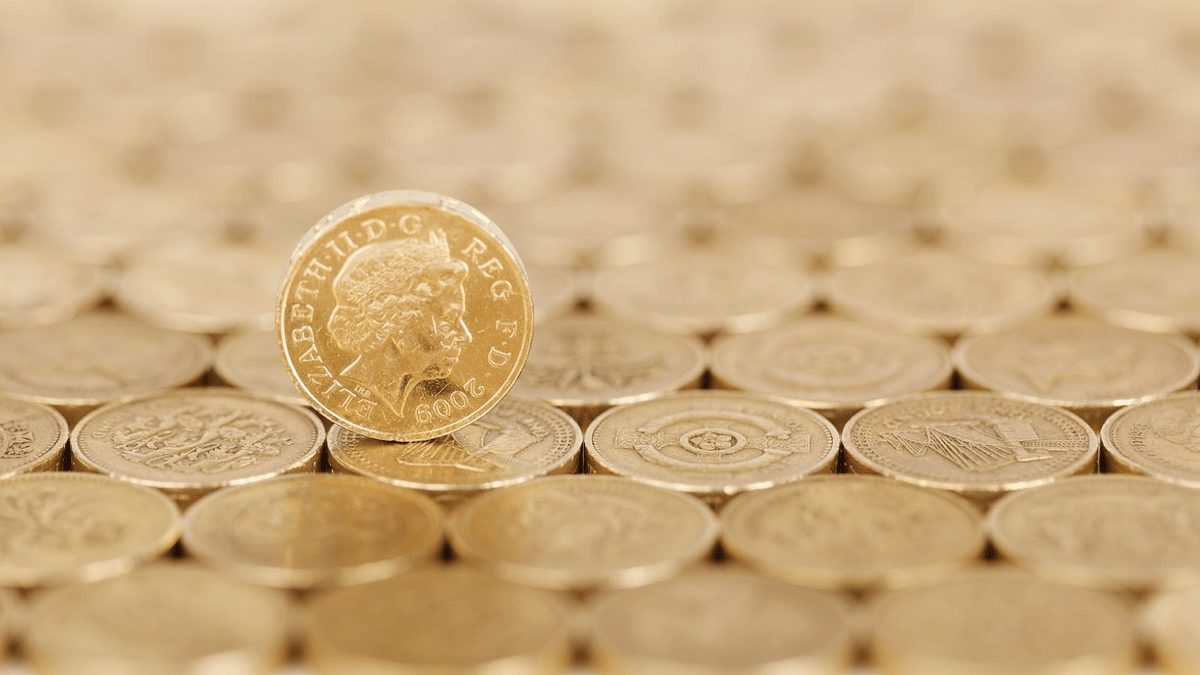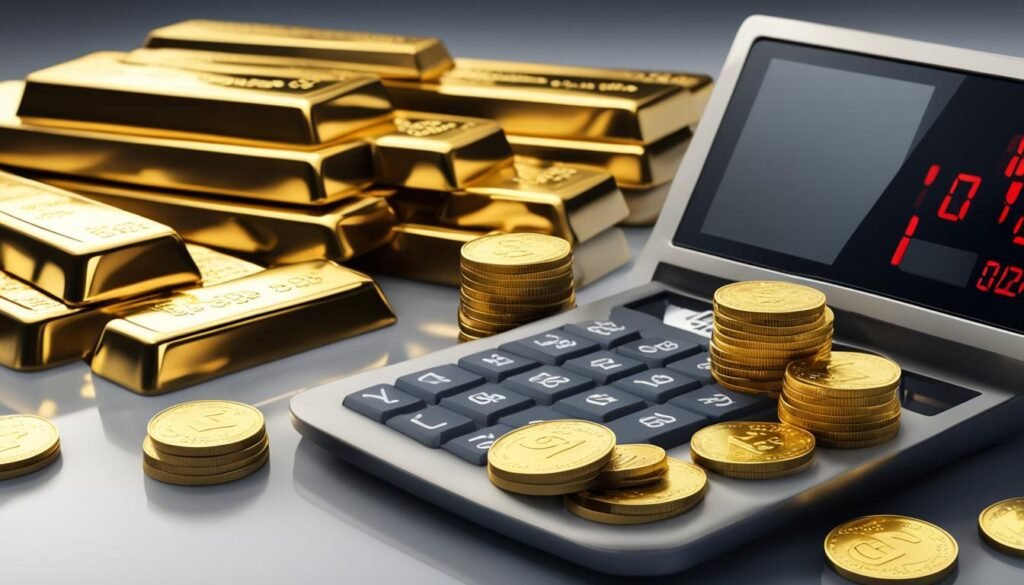Table of Contents
As an object of wealth and a cornerstone in the realm of gold investment, the 12kg gold bar stands out as a beacon of significant value. The allure of this substantial gold bullion investment extends beyond its sheen, reaching into the dynamics of current gold bar prices and the broader precious metals market.
Whether for seasoned investors or curious onlookers, the worth of a gold bar, particularly one weighing a hefty 12 kilograms, is tied to several critical factors, each playing a role in the bar’s final market price.
Given the size and worth of these bars, understanding their true value necessitates a keen look at global market tendencies, purity standards, and the various costs associated with acquiring such high-value gold bullion.
Intrinsic to establishing the 12 kilogram gold value is the spot price of gold, an ever-fluctuating number that sows the seeds of opportunity and potential for those involved in the market.
The grandeur of a 12kg gold bar makes it a rarity and an item often reserved for substantial financial moves within the fabric of global investment, brimming with both intrigue and potential.
Key Takeaways
- The value of a 12kg gold bar intertwines with the current gold investment landscape and shifts in the spot price.
- Purity, characterized by fineness, is a pivotal factor in the worth of gold bars in the market.
- Premiums on gold bar price and transaction fees can substantially affect the overall cost.
- Gold’s inherent volatility and global economic conditions shape investor demand and the gold bullion market.
- Transparency in pricing from dealers, such as Hero Bullion, is essential for investors to navigate costs effectively.
Overview of the 12kg Gold Bullion Market
Within the realm of precious metals, the 12kg gold bar stands as a titan, its heft and value earning it an esteemed position in the gold bullion market.
Often overshadowed by more common investment sizes, these substantial gold bars make a statement of serious wealth and commitment to physical gold.
For those looking to partake in significant gold investments, understanding the market dynamics and the unique allure of these gold giants is essential.
The Rarity and Significance of 12kg Gold Bars
12kg gold bars are a rarity, not often found within casual gold bar collectors’ vaults or in average investors’ portfolios. Their rarity is not just a matter of size, but also a reflection of the substantial financial undertaking they represent.
For the significant gold investments sector, these bars are more than just bullion; they are the apex of asset allocation in physical form, often serving as the backbone for large-scale precious metal strategies.
Who Typically Invests in Large Gold Bars?
Stacking gold bars, especially those of the 12kg variety, is typically a pursuit for the financially fortified—high net-worth individuals, institutional investors, or sovereign governments who see the pragmatic edge in holding physical gold on such a scale.

However, the luxury and exclusivity of owning such heft in gold also attracts hobbyists and gold bar collectors. These individuals appreciate not only the monetary aspects but also the historical and cultural significance attached to accruing wealth in its most ancient and tangible form.
Whether for the sake of diversification, wealth preservation, or sheer admiration, investing in these large gold bars aligns one with a lineage of savers and collectors dating back centuries, continuing the legacy of valuing gold as a cornerstone asset.
This nuanced layer of the gold bullion market is what continues to intrigue and attract significant gold investments from a global cohort of discerning investors and eminence-seeking collectors.
Current Market Conditions Affecting Gold Value
Understanding the complexities of the precious metal market requires a nuanced look at the various factors that contribute to the gold market volatility.
The valuation of gold, particularly in large quantities such as a 12kg bar, can be heavily influenced by shifting investor sentiments and macroeconomic indicators, resulting in gold price swings that both new and seasoned investors should monitor closely.
The Volatility of Gold Prices
Gold, historically a bastion of stability, has not been immune to the tumultuous winds of market change. The precious metal market is sensitive to a multitude of variables that can incite rapid movements in gold prices.
This volatility is exemplified by the fact that the rate of a 12kg gold bar may experience substantial fluctuations within a remarkably short time frame.

Factors Influencing Investor Demand for Gold
At the heart of the matter lies investor demand for gold. This demand is not static but rather a responsive force to a global supply chain and the resulting availability of these bars.
Besides this interplay of supply and demand, other contributing factors include geopolitical tensions, currency fluctuations, and even the performance of other asset classes, which can sway an investor’s propensity to amass or divest from gold holdings.
Additional global economic factors can impact the desire for gold investment; these typically behave inversely to economic performance, with downturns in the stock market or economy at large often leading to an uptick in the appeal of gold as a ‘safe haven’ asset.
The dynamics of the gold market are therefore as multi-faceted as they are compelling, and grasping the depth of these conditions is indispensable for any serious participant within the precious metals arena.
Purity and Fineness of Gold Bars
When diving into the world of precious metals, one term stands out among others: the purity of gold. This purity, which often presents itself as a percentage, is critical in assessing the true value of gold products.
This is why the fineness of gold bars is not merely a technical detail, but the foundation of their monetary and investment worth. For those looking at a solid pure gold investment, understanding what constitutes the gold bar content isn’t just recommended—it’s essential.
Gold bars come in various fineness levels, with common standards including .999 and .9999 purity. These numbers might seem inconsequential at first glance, but the reality is that they represent the amount of pure gold content within a bar, relative to any other metals that may be used as alloys.
Thus, for investors, particularly those eyeing heftier assets like a 12kg gold bar, knowing the exact fineness is paramount.
Let’s consider the subtle yet significant differences in gold purity levels:
- Investment-grade gold is primarily produced at a purity of .995, which equates to 99.5% pure gold.
- The most commonly known and traded form of gold is .999 fine, known also as “three nines fine,” which means 99.9% purity.
- Some of the finest gold bars are .9999 purity, making them exceptionally desirable and sometimes referred to as “four nines.”
The highly sought-after .9999 fineness reflects a nearly pure gold bar, with such high levels of purity being particularly attractive for those looking at gold bar content as a long-term investment. It is because of the intrinsic value contained within the nearly pure construct of such gold bars that they naturally command a higher premium on the market.
In summary, when assessing the value of large gold bars, it is these tiny percentages that distinguish between a good and a superior pure gold investment. It is always advisable to inquire about the fineness of any gold bar prior to purchase to ensure an investment that retains enduring value and stability.
Understanding Premiums and Markups on Gold
When investing in gold bars, comprehending the additional costs above the base value is essential for accurate financial planning. Spot price premiums reflect the market’s pulse, while gold dealer markups reveal the competitive landscape in the industry. Both these elements combine to influence the final cost of ownership for investors and collectors.
Calculating Premiums Above the Spot Price of Gold
Gold premiums are essentially the extra charges over the spot price of gold, which serve to cover the costs of distribution, fabrication, and dealer profit.
These premiums can change based on the size of the gold bar—with larger bars, such as the standard 12 kilograms, usually attracting lower premiums compared to smaller units. This makes investing in gold bars more economically efficient for large-scale investors.
Comparing Premiums Across Different Gold Dealers
Finding the best deal on gold investments necessitates a comparative analysis of premiums charged by various dealers. Such comparisons enable investors to discern between higher and lower gold dealer markups and to consequently make informed decisions. Here are essential considerations for comparing these premiums:
- Dealer Reputation: Established dealers are more likely to offer competitive and reliable premiums.
- Volume Discounts: Purchasing larger quantities or bigger bars could net investors substantial savings.
- Market Conditions: Premiums can fluctuate with market volatility, making timing a strategic factor.
Ultimately, astute investors stay vigilant to spot price premiums and gold dealer markups to ensure their foray into gold bar investments is as profitable as it can be.
Sorting Through Transaction Costs and Fees

When diving into the intricacies of gold investing, one must navigate the oft-overlooked realm of gold bar transaction fees, hidden costs, and bullion dealer fees – elements critical to the financial soundness of purchasing high-value bullion like 12kg gold bars.
Understanding these additional expenditures is key to effectively evaluating your investment and securing a transaction devoid of unwanted surprises.
The table below breaks down the types of charges you might incur, aiding in making a smart, informed choice when engaging in gold transactions.
| Type of Fee | Description | Typical Range |
|---|---|---|
| Commission Fees | Charged by dealers for facilitating the transaction | 0.5% – 5% of the gold value |
| Shipping Fees | Costs to securely transport the gold bar | Varies based on distance and insurance |
| Insurance Fees | Covers potential loss or damage during transit | Dependent on gold value and shipper policy |
| Storage Fees | For securing gold bars in a vault or safe facility | Annual fee based on % of gold value or flat rate |
| Payment Processing Fees | Applied to credit card or electronic transfer payments | 2% – 4% of the total transaction |
Investors should press for transparency from bullion dealers regarding all fees to ensure they are not only getting a fair deal but also to safeguard against any hidden costs in gold investing.
Whether you’re dealing with local or online dealers, ask for a comprehensive breakdown of all costs before finalizing your gold bar purchase.
Acknowledging these additional expenses will provide a clear-eyed view of the true cost of gold ownership and prevent costly misconceptions. This informed approach will enable you to precisely evaluate your investment beyond the lustrous appeal of the physical gold itself. Always remember, in an arena as sophisticated as gold investing, awareness is gold.
Step-by-Step Calculation: Valuing a 12kg Gold Bar
When it comes to valuing gold bars, one cannot overlook the importance of meticulously analyzing the gold spot price calculation, gold weight conversion, and calculating gold worth. These factors serve as the foundation for understanding the market value of gold bullion. Below, we’ll explore how to methodically determine the value of a substantial 12kg gold bar.
Starting with Spot Price: Gold Price Per Troy Ounce
The journey of valuing a 12kg gold bar begins with identifying the current spot price of gold per troy ounce. This spot price is a crucial indicator that reflects the instantaneous price for transactions and settlements in the precious metals market.
Rather than being static, the gold spot price fluctuates constantly during market hours, influenced by a plethora of factors including but not limited to market sentiment, geopolitical stability, and currency values.
Conversion Factors: Troy Ounces to Kilograms
Once the gold spot price per troy ounce is ascertained, the next step involves converting this figure to kilograms to gauge the worth of our 12kg gold bar.
The standard conversion factor used in this translation is 32.1507 troy ounces to one kilogram, a precise multiplier that enables investors to convert and compute values between different mass units utilized in the gold trade.

To illustrate the process and facilitate a clearer understanding of the valuation, let’s consider a straightforward example:
| Parameter | Value |
|---|---|
| Current Spot Price (per troy ounce) | $1,800 |
| Conversion Factor (troy ounces to kilograms) | 32.1507 |
| Gold Weight (kilograms) | 12 kg |
| Spot Price (per kg) | $57,871.26 |
| Total Value of 12kg Gold Bar | $694,455.12 |
This table encapsulates the fundamental arithmetic involved in deriving the value of a 12kg gold bar. Initially, we establish the spot price per troy ounce and use our conversion factor to find the spot price per kilogram.
Next, by extending this valuation across the entire weight of the gold bar, we obtain the market worth of the 12kg gold bar. It’s important to note that this value represents a base calculation, prior to the inclusion of premiums, dealer markups, or any additional fees associated with the purchase or sale of gold bullion.
Through this methodical approach to determining gold value, investors are equipped with the knowledge to make informed decisions about their gold investments. Whether you’re a seasoned gold trader or a newcomer to the realm of precious metals, understanding these calculations is imperative for gauging the true value of your assets.
Factoring in Additional Premiums and Charges
When investing in gold bullion, savvy investors understand that the true cost extends beyond the base value determined by the spot price conversion.
It is crucial to account for gold bar premiums which are often influenced by factors such as market demand, rarity, and the bar’s size. These premiums can vary between sellers and might change based on the fluctuating conditions of the gold market.

Apart from premiums, there are several additional charges in gold investment to be considered. These could include shipping costs, insurance during transit, storage fees if applicable, and possibly payment processing fees. For those who opt for secure storage facilities, there may be ongoing costs associated with maintaining the security and integrity of the investment.
Investors should always enquire about total costs upfront to prevent any unexpected gold bullion charges that could impact the investment’s profitability.
Let’s break down these costs further:
- Dealer Premiums: This is added above the spot price of gold and compensates the minting costs, distribution, and dealer’s profit margin.
- Shipping Costs: Determined by the weight and insurance value of the gold bar, as well as the shipping distance.
- Insurance: Protects against loss or damage during transit and while stored.
- Storage Fees: If opting for third-party storage, quarterly or annual fees could apply, depending on the facility.
- Payment Processing Fees: Credit card or bank transfer fees can apply, depending on the dealer’s policies.
To effectively manage these additional expenditures, it’s advised that investors maintain an open dialogue with their chosen gold dealer, as transparent pricing details ensure informed decision making. Additionally, it is beneficial to compare the rates of gold storage and insurance options to secure the most cost-effective means of safeguarding this precious asset.
Being aware of the potential for varying gold bar premiums and additional charges in gold investment is a testament to the thoroughness necessary in managing a sound gold portfolio. Such diligence ensures that the actual costs are in line with an investor’s financial strategies and that the investment in gold bullion remains a solid pillar in one’s asset array.
How Market Dynamics Influence Gold Prices
The interplay of global economic events, investor sentiment, and the balance between gold supply and demand collectively drives the gold market dynamics. These elements are constantly shaping the landscape of the gold market and, as a result, the fluctuating value of gold commodities such as 12kg gold bars. Understanding the complexities of these factors is essential for any investor maneuvering within the realm of precious metals.
Global Economic Impacts on the Price of Gold
Economic stability, or the lack thereof, correlates closely with gold prices. In times of uncertainty, investors often turn to gold as a safe haven asset, leading to increased demand and higher prices. Conversely, a robust economy may see gold prices fall as investors seek higher returns in other markets. Tracking these economic impacts provides a window into potential trends within the gold market.
Supply and Demand Fluctuations in the Gold Market
Predicting gold prices can be as much an art as a science due to the ever-shifting nature of supply and demand. Factors such as mining production, central bank policies, and technological advancements in gold-utilizing industries can all affect the amount of gold available.
Similarly, demand can be influenced by cultural trends, market speculation, and geopolitical tensions. Together, these supply and demand forces create a dynamic and sometimes unpredictable gold market.
| Economic Indicator | Impact on Gold Supply | Impact on Gold Demand | Resulting Influence on Gold Prices |
|---|---|---|---|
| Inflation rates | Stable | Increased investment in gold | Higher prices |
| Central Bank Reserves | Varying levels of sales/purchases | Institutional demand fluctuations | Volatile prices |
| Geopolitical Tensions | Stable unless mining areas affected | Increased safe-haven buying | Higher prices |
| Technological Innovations | Increased mining efficiency | Industrial demand variability | Mixed impact on prices |
Investors need to remain vigilant and informed about these constantly evolving elements to make strategic decisions. As the global economic scenario and gold supply and demand dynamics continue to evolve, so will the strategy for investing in gold and assets like 12kg gold bars.
Local Versus Global: Market Variations
When diving into the intricacies of the local gold market and its relation to the global gold market, investors must acknowledge the interplay between them.
Local markets are often more sensitive to gold demand variations and can see fluctuations at a rate different from the global pace.
Understanding the nuances of gold dealer locality is just as crucial as grasping global market forces when evaluating a significant investment like a 12kg gold bar.
In local markets, the accessibility of gold can change due to a variety of factors such as mining output within the region, import taxes, and nation-specific economic health. These conditions influence local premiums and dealer charges which ultimately impacts the cost of gold bars.
Conversely, the global market is driven by broader economic indicators and global supply and demand which may lead to a different pricing structure.
To illustrate, here is a comparative analysis of gold prices:
| Aspect | Local Gold Market | Global Gold Market |
|---|---|---|
| Availability | Subject to regional mining and trade policies | Determined by worldwide production and reserves |
| Premier Charges | Varies with dealer and local demand | More uniform, reflecting international standards |
| Investor Demand | Can fluctuate intensely with local economic conditions | Typically steadier, reflective of diverse global investment portfolios |
| Economic Impact | Directly affected by national economic indicators and policies | Driven by global economic performance and geopolitical factors |
| Price Discovery | Often dictated by localized trade and investment circles | Influenced by global exchanges and worldwide trading trends |
While the gold dealer locality may offer more personable interactions and potentially quicker turnarounds for transactions, the global market can provide a wider perspective and diversity in a portfolio.
Therefore, balancing local and global market insights is fundamental in establishing a well-informed approach to investing in the gold market, whether for individual collectors or institutional investors.
Grasping Gold Bullion Dealer Pricing Models
When stepping into the world of gold bullion investment, understanding the diversity of pricing approaches that dealers employ is paramount. Not all gold bullion dealers are created equal, and the savvy investor must navigate through varied pricing models to secure the best possible deal.
Factors contributing to the differences in pricing include overhead costs, market positioning, and volume of sales, each playing a role in shaping the cost structure for gold bullion products.
Transparency and Comparing Costs Among Dealers
In an industry where pricing transparency is highly valued by investors, clear communication of costs and premiums is a distinguishing feature of reputable gold bullion dealers.
Investors benefit greatly from comparing costs between dealers to understand where the value lies.
Utilizing gold dealer comparisons, customers can reveal the competitiveness of a dealer’s gold bar pricing models and decide where to purchase their precious metal assets.
Why Prices Vary Between Gold Dealers
Prices for gold bars can vary significantly between dealers for a variety of reasons, including differences in overhead, volume discounts, sourcing methods, and customer service offerings.
Some dealers may offer reduced premiums for larger purchases or frequently adjust prices to mirror the fluid market conditions, making it imperative for investors to continuously monitor these changes for optimal purchase timing.
| Gold Dealer | Transparency Level | Price Above Spot (per oz) | Volume Discount | Customer Service Rating |
|---|---|---|---|---|
| Dealer A | High | $20 | Yes | 5/5 |
| Dealer B | Medium | $25 | No | 4/5 |
| Dealer C | Low | $30 | Yes | 3/5 |
In summary, investors seeking to buy or sell gold bullion must closely examine and compare gold bullion dealers to ensure the pricing models align with their investment goals. It is through due diligence in evaluating costs, premiums, and overall transparency that one can most effectively participate in the precious metals market.
The Nuances of Selling and Buying 12kg Gold Bars
Entering the realm of trading 12kg gold bars is both exclusive and intricate. It’s a space where the stakes are high, and the transactions necessitate a partnership with trusted gold dealers and refiners. Investors and collectors should be vigilant about the authenticity, pricing, and provenance of the gold bars to ensure that their high-value dealings are indisputable and secure.
Selecting Trustworthy Gold Dealers and Refiners
Finding a dealer you can trust to conduct gold bar sales is paramount. Reputable dealers will have established a history of transparent procedures, robust client testimonials, and certifications from recognized industry organizations. They should offer thorough documentation and stand prepared to answer any queries regarding the history and purity of the bars they sell.
Negotiating Prices and Appraising Large Gold Bars
When it comes to gold bar purchase negotiation, one must possess the acumen for understanding the market’s pulse.
The art of negotiation will rest heavily on the current gold prices, but also on the buyer’s ability to appreciate the subtleties of appraising large gold bars.
This valuation goes beyond mere weight and purity—it encompasses market demand, potential collector interest, and historical value.
- Establish the fair market value of the gold based on current spot prices.
- Factor in premiums for size and purity typical in the large bar market.
- Investigate costs for security and transport, adding them to your baseline price.
Conducting transactions with such valuable assets is no small feat, and buyers should proceed with due diligence to secure a fair and advantageous deal.
| Consideration | Importance | Details |
|---|---|---|
| Dealer Reputation | High | Check for membership in industry associations and client feedback. |
| Negotiation Leverage | Medium | Knowledge of the current market can give buyers the upper hand. |
| Appraisal Expertise | High | Understanding the intricacies of large gold bars is key to establish true value. |
Undoubtedly, transactions involving high-caliber gold bars like the 12kg variety are delicate and require a sophisticated approach—making them a distinctly nuanced segment of the precious metals market.
Conclusion
In the complex world of precious metals investment, determining gold worth, especially for sizable assets like a 12kg gold bar, involves a multifaceted approach.
The interplay of market forces, the fineness of the bullion, and varying premiums and additional costs all dictate the final valuation of such an investment. It is not a straightforward task; it requires diligence and attention to detail.
Whether you’re an experienced collector or a new investor, understanding these elements is vital in accurately determining the worth of gold bars.
Investment in 12kg gold bars is a significant undertaking, demanding continuous monitoring of the gold market. Staying abreast of price fluctuations influenced by global economic conditions, supply and demand, as well as geopolitical factors, is essential for maintaining the value of one’s investment.
Moreover, building relationships with reputable dealers is crucial given that premiums and fees can substantially affect the investment’s bottom line.
A careful approach to these interactions can ensure that your large-scale gold investments remain sound and profitable.
As investors navigate through the intricacies of the gold market, final thoughts on 12kg gold bars hinge on the synergy between astute market awareness and prudent financial decisions.
The gold bar investment summary for such an asset should underline the need for a thorough understanding of the market, an appreciation for the bar’s purity, and the implications of any associated costs.
With these strategies in place, the allure of gold remains undiminished, sustaining its status as a coveted asset among discerning investors seeking to balance their portfolios with the timeless value of gold.
FAQ about Worth of a 12kg Gold Bar
How is the worth of a 12kg gold bar determined?
The worth of a 12kg gold bar is determined by the current market gold spot price, its purity or fineness, and additional premiums or markups from dealers, as well as any transaction fees associated with the purchase.
What are the characteristics that make 12kg gold bars rare and significant?
The rarity and significance of 12kg gold bars stem from their large size and value, making them uncommon in personal investment portfolios and more typical among serious investors and collectors within the gold bullion market.
Who typically invests in large gold bars like the 12kg size?
Large gold bars, such as the 12kg variety, are commonly the domain of substantial investors, including institutional buyers, wealthy individuals with significant gold investments, and dedicated gold stackers.
How does the volatility of gold prices affect the value of a 12kg gold bar?
The volatility of gold prices can lead to rapid swings in the market value of a 12kg gold bar, potentially altering its worth significantly in a short period of time. This volatility is influenced by global economics, investor demand, and market conditions.
What factors influence investor demand for gold bullion?
Investor demand for gold bullion is influenced by various factors, including global economic conditions, market trends, currency values, and overall investor sentiment towards gold as a safe-haven asset.
What does the fineness of gold bars indicate?
The fineness of gold bars indicates their purity level, with most bars being at .999 or .9999 purity. This means they contain 99.9% or 99.99% pure gold, which directly impacts their market value.
How are premiums above the spot price of gold calculated?
Premiums above the spot price of gold are calculated based on the current gold market conditions, the costs of production, and the markup applied by the gold dealer. These premiums cover the dealer’s overhead and allow for a profit margin.
How do premiums across different gold dealers compare?
Premiums can vary significantly across different gold dealers based on factors such as dealer size, operating costs, and competitive positioning. It’s important for investors to compare premiums and choose a dealer that offers reasonable rates and transparent pricing.
What are some common transaction costs and fees when buying gold bars?
Common transaction costs and fees when buying gold bars can include shipping and handling, insurance, payment processing fees, and potentially storage fees if utilizing third-party secure storage facilities.
How do you start the calculation for valuing a 12kg gold bar?
To start valuing a 12kg gold bar, establish the current gold spot price per troy ounce, then use the conversion factor of 32.1507 to determine the price per kilogram, which is then multiplied by 12 to estimate the base value of the gold before premiums and fees.
How do you convert the spot price per troy ounce to the value of a 12kg gold bar?
Convert the spot price per troy ounce to the value of a 12kg gold bar by multiplying the price per ounce by the conversion factor of 32.1507 to get the price per kilogram, and then multiply that figure by 12 for the total kilogram weight.
What additional premiums and charges should be factored into the cost of a 12kg gold bar?
When considering the cost of a 12kg gold bar, factor in the premiums over the base spot price, any dealer-specific markups, as well as potential charges for payment processing, shipping, insurance, and storage if applicable.
How do global economic impacts and supply and demand fluctuations influence the price of gold?
Global economic impacts, like recession or growth, political stability, and currency fluctuations, as well as supply and demand dynamics, affect investor sentiment and consequently influence the market price of gold. This can be inversely related where gold prices often rise during periods of economic uncertainty.
Why might local gold market conditions differ from global trends?
Local gold market conditions might differ from global trends due to factors such as regional demand, local dealer markups, currency values, and availability of gold, which can result in different pricing and investment considerations.
Why is pricing transparency important when dealing with gold bullion dealers?
Pricing transparency is crucial when dealing with gold bullion dealers because it ensures that investors can clearly understand the full cost of their investment, including any premiums, fees, or additional charges, thereby enabling them to make informed decisions.
How do gold bullion dealer pricing models vary?
Gold bullion dealer pricing models vary based on their operational costs, the volume of gold they trade, their target market segment, and competitive strategies. Investors should compare these models to ensure they are getting a fair market price.
Why is it important to select trustworthy gold dealers and refiners?
Selecting trustworthy gold dealers and refiners is important to ensure authenticity, fair pricing, and to avoid overpricing or fraudulent transactions, particularly when dealing with high-value items like 12kg gold bars.
What strategies can be used when negotiating prices and appraising large gold bars?
Strategies for negotiating prices and appraising large gold bars include staying informed about the current gold market conditions, understanding fineness and weight measures, and being well-versed in premiums and total cost calculations to facilitate fair and transparent dealings.








